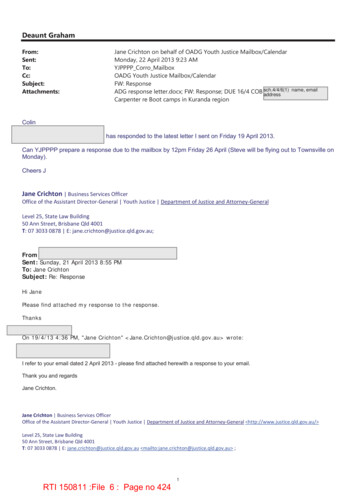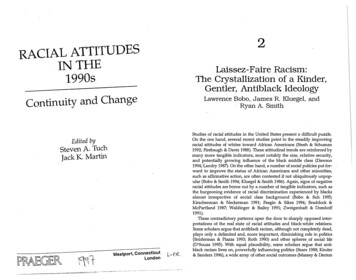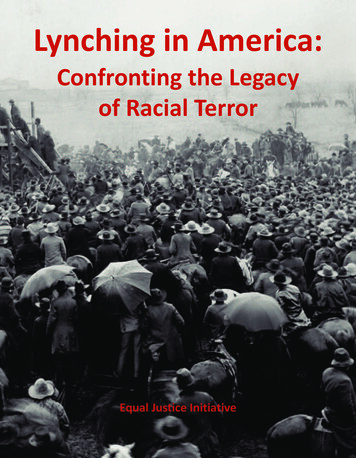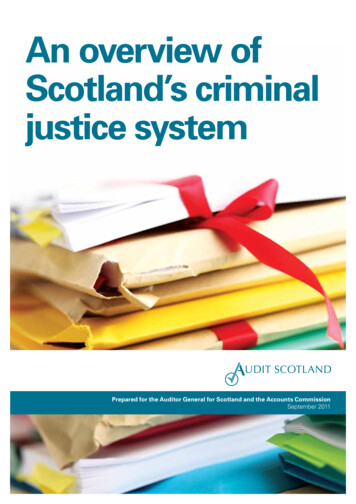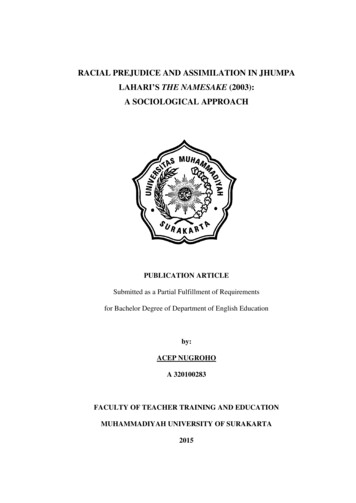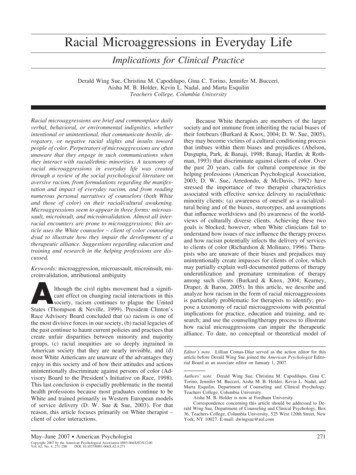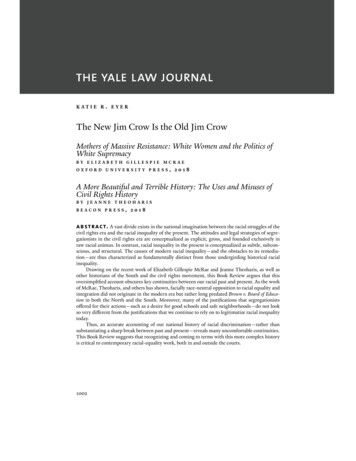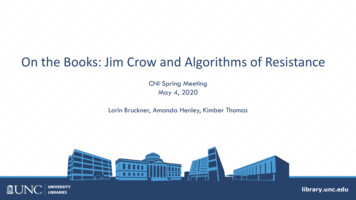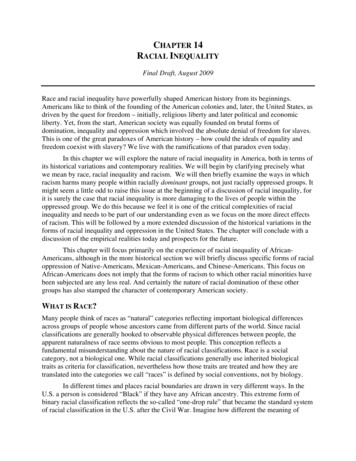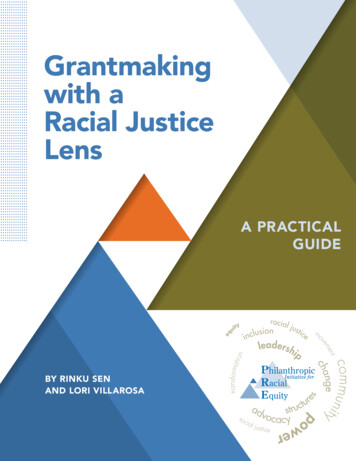
Transcription
Grantmakingwith aRacial JusticeLensA PRACTICALGUIDEBY RINKU SENAND LORI VILLAROSA
2G R A N T M A K I N G W I T H A R AC I A L J U S T I C E L E N S : A P R AC T I C A L G U I D E
Table of ContentsIntroduction. . . . . . . . . . . . . . . . . . . . . . . . . . . . . . . . . . . . . . . . . . 4Make the Case for a Racial Justice Lens. . . . . . . . . . . . . . . . . . . . . 8The Difference Between Racial Equity and Racial Justice . . . . . . . . . . . 8Align Foundation Practices with a Racial Justice Vision. . . . . . . . 11Develop Explicit, Shared, and Tested Language . . . . . . . . . . . . . . . . . 11Set Your Goals, and Follow Through . . . . . . . . . . . . . . . . . . . . . . . . . . 13Remember That Identity is Not Analysis . . . . . . . . . . . . . . . . . . . . . . . 14Address Resistance. . . . . . . . . . . . . . . . . . . . . . . . . . . . . . . . . . . . . . . . 15Don’t Run Away From Conflict. . . . . . . . . . . . . . . . . . . . . . . . . . . . . . . 15Create Opportunities to Revisit and Strengthen RacialJustice Commitments. . . . . . . . . . . . . . . . . . . . . . . . . . . . . . . . . . . . . . 17Am I Aligning Every Aspect ofMy Foundation to Racial Justice?. . . . . . . . . . . . . . . . . . . . . . . . . . . . . 18Invest in Racial Justice. . . . . . . . . . . . . . . . . . . . . . . . . . . . . . . . . 19WHAT TO FUNDPrioritize Building Power. . . . . . . . . . . . . . . . . . . . . . . . . . . . . . . . . 19Redefine Impact . . . . . . . . . . . . . . . . . . . . . . . . . . . . . . . . . . . . . . . 21Make Course Corrections. . . . . . . . . . . . . . . . . . . . . . . . . . . . . . . . 22HOW TO FUNDSupport Movement Ecosystems. . . . . . . . . . . . . . . . . . . . . . . . . . . 30Ease the Burden on Grantees. . . . . . . . . . . . . . . . . . . . . . . . . . . . . 34Be Accountable to the Racial Justice Field. . . . . . . . . . . . . . . . . . . 37Critical Questions to Ask When Selecting Tools and Resourcesfor Aligning Your Foundation with Racial Justice. . . . . . . . . . . . . 39The Way Forward. . . . . . . . . . . . . . . . . . . . . . . . . . . . . . . . . . . . . 42Appendix: Tools and Resources for Aligning YourFoundation with Racial Justice. . . . . . . . . . . . . . . . . . . . . . . . . . . 43Acknowledgements. . . . . . . . . . . . . . . . . . . . . . . . . . . . . . . . . . . 50G R A N T M A K I N G W I T H A R AC I A L J U S T I C E L E N S : A P R AC T I C A L G U I D E3
IntroductionSince 2003, the Philanthropic Initiative for Racial Equity (PRE) hasconducted research, convened, and consulted with foundations to raiseawareness of structural racism and to establish racial equity as a coreaspect of excellent philanthropy.work that includes philanthropic affinity groups,strategic consultants, and intermediaries. This evolving,multidisciplinary practice is what we have come to callgrantmaking with a racial equity lens.In 2006, we brought this knowledge to partner withGrantCraft in co-producing Grantmaking with a RacialEquity Lens,1 which examined how to advance racialequity in philanthropy. At the time, PRE’s emphasison addressing structural racism and centering racialequity as grantmakers’ core goal and practice wasin contrast to prevailing popular strategies, such as“colorblindness,” “universal” approaches, or focusingon staffing diversity.Grantmaking with a Racial Justice Lens: A PracticalGuide centers the perspectives of racial justice activistsfirst, and then of funders working on change in theirinstitutions, to identify best practices for drivingphilanthropy beyond racial equity toward racial justice.PRE and our partners defined a racially equitableworld as one in which the distribution of resources,opportunities, and burdens is not determined orpredictable by race. We argued that an explicitracial equity lens ensures that the particular needsand assets of communities are taken into account,and that diversity, while important, is insufficientfor addressing the deep-seated power imbalancesendemic to philanthropy. Grantmakers’ attention toracial equity has supported racial justice activists andhelped to nurture a growing field of philanthropicThis guide will be most useful to an audience ofgrantmakers who have already made or are close tomaking racial equity commitments, and who want todrive their work into more ambitious territory thatincludes power building and structural transformation.Through reflections and frameworks built from thedirect experience of activists and funders, we offerpractical steps and solutions for advancing racial justicegrantmaking in any philanthropic setting.Communities of Color on the Front Lines ofTransformational ChangeIt is clear that the most impactful work in the countryis often done by Black and other people-of-color-ledorganizations that are deeply committed to long-termsystems transformation. The phenomenal work of Blackwomen-led organizations to deliver historic electoralwins, the transformative work of Indigenous leadershipto defend Standing Rock, and breakthrough work onimmigration rights are just a few examples of organizingin communities of color that is redefining change workand breathing new life into U.S. democracy.Philanthropy has been making a shift towardrecognizing these assets and away from the olddominant paradigm of limited, deficit-orientedfunding. The last ten years have seen the rise of anew generation of racial justice leaders from everycommunity, building power among everyday peopleand making structural change. Activism on racial issues,if not at a provable all-time high, is certainly drawingnew recruits at historic levels. Organizations and leaderscampaign on a larger scale and with a wider array of1Grantmaking with a Racial Equity Lens was co-developed in 2006 and published January 2007 by the Philanthropic Initiative for Racial Equity (PRE) andGrantCraft. At that time, GrantCraft was a project of the Ford Foundation, and in 2011 moved to Foundation Center. In 2019, Foundation Center merged with GuideStarto form Candid.4G R A N T M A K I N G W I T H A R AC I A L J U S T I C E L E N S : A P R AC T I C A L G U I D E
sophisticated tools than at any other time in the lastfifty years, bringing enough daily media attention tokey issues to drive informal conversation around theproverbial water cooler. The vast scope of those keyissues underscores the role of racial discrimination inevery aspect of life, from birth to death.The work of racial justice groups has fueled impactfulchange across the country—and the benefits of thesechanges reach far beyond communities of color. InFlorida, for example, Black-led organizations anchoredthe campaign to pass Amendment 4, which restoredvoting rights to people with felony convictions. Only28 percent of those people are Black; a small portionis Latinx and everyone else is white. Communities ofcolor have also led the way on environmental issuesthat benefit everyone. In California, multiple countieshave banned fracking as a result of organizing by NativeAmerican and other communities of color. Finally, thecorporate accountability campaigns led by groupsof color are forcing change at large companies likeGoogle, which banned ads by bail bond companies,and have driven corporate sponsors away from theAmerican Legislative Exchange Council (ALEC), theright-wing legislative powerhouse. Proximity to affectedcommunities, development of local leaders, andknowledge of the best potential solutions are all assetsthat racial justice groups led by people of color bring totheir work.In addition to protest and civic action, the racial justicefield has also built its communications capacity andpursued culture-shift strategies. These strategieshave engaged celebrities and interventions in fieldsfrom sports to fashion, bringing racial justice out oftechnocratic fields and into more accessible arenas.Today, community groups and networks of color sitin television writers’ rooms, and key racial justiceorganizations are name-dropped in dramas andcomedies; the Associated Press has removed “illegalimmigrant” from its style guide.Finally, strategists are connecting social movementactivity with other forms of social change. There ismore coordination and overlap between the socialmovement and civic engagement sides of the racialjustice house, and activists are entering into new formsof organization, including 501c4 efforts. Organizersare also incorporating direct service provision, newcommunity spaces, and the creation of alternativeinstitutions into their strategies.Funders are grasping the important role of advocacyand organizing and how they interact with otherstrategic threads. The mass protests of the last decadehave forced the nation to confront the systemic natureof phenomena like police violence and environmentaldegradation. Dynamic campaigns and strategies haverevealed the benefits of direct action, especially incombination with civic, cultural, legal, and servicestrategies in shifting institutional policy and practice.These developments have been accompanied bya burst of creativity in social change methods, withemphasis on engaging real people in meaningful civicaction, whether it be voter registration, protest, or newforms of community service.ABOUT THIS GUIDEThroughout the guide, you will find useful tools for implementing aracial justice lens to boost your foundation’s success at supportingstructural transformation and building power in our communities.G R A N T M A K I N G W I T H A R AC I A L J U S T I C E L E N S : A P R AC T I C A L G U I D E5
Methodology and StyleGrantmaking with a Racial Justice Lens has been developed through a three-part process that emphasizedqualitative data. We began with focus groups and direct interviews with staff at racial justice organizationsthroughout the U.S. to uncover critical questions about philanthropy in this area. Those questions included: What do racial justice activists want funders to know and change to increaseeffective and sustainable support for their work? How do funders understand and define racial equity, racial justice, and powerbuilding? What are change agents within philanthropy running into as barriers toadvancing racial justice grantmaking, and how are others overcoming thosebarriers? How do funders hold themselves accountable to transformative racial justicegoals?To answer these questions, we interviewed diverserepresentatives from foundations of varying size,type, and geography, and at various stages along acontinuum of racial justice work. Our philanthropicinterview and focus group participants represent a broadrange of public, private, community, and intermediarygrantmaking institutions in regions across the U.S., aswell as more than a dozen global funders who providedcritical insight into overarching themes that will behighlighted in future publications.A diverse team of researchers conducted more than fiftyinterviews, led six focus groups, and held stakeholdermeetings with activists and with staff from foundationsand intermediary and support organizations in personand by phone, email, and video conference from August2017 to October 2019.Another data set came from PRE program activitiesconducted in 2018 and 2019. The resulting insights andarguments were tested in PRE Racial Justice FunderLabs and cohorts that, in turn, engaged dozens morefoundations. These gatherings featured activist-led andpeer-learning activities, and included funders who hadalready been using a racial equity lens and have beenmoving toward a racial justice lens.6The research and writing team read the transcripts fromevery focus group and interview, pulling out themes andkey lessons. Simultaneously, PRE staff tracked discussionsand examples that arose during labs and cohortmeetings.Anonymity allowed for greater candor as well as a focuson the transferability of any particular experience orinsight. We do not attribute these insights and stories,identifying interviewees only by descriptors such as theirposition, racial/ethnic identity, gender identity, sexualorientation, issue focus, type of foundation, and region.We choose descriptors relevant to the context of thequote to convey the range of voices, but in ways thatpreserve anonymity. Accordingly, we sometimes use abroader ethnic/racial or foundation-type category ratherthan something more specific that could identify thespeaker. We use Latino/a when quoting a person whoidentifies as such, and Latinx for the broader community.Quotes and personal accounts have been edited forclarity, not content.G R A N T M A K I N G W I T H A R AC I A L J U S T I C E L E N S : A P R AC T I C A L G U I D E
Developments in Racial Justiceand PhilanthropyWith decades of progress under threat, these timesdemand the best of our collective abilities. The nationalcontext has been defined by the pendulum shiftrepresented by the elections of Barack Obama andDonald Trump, as well as by many lessons learned fromthe struggles and victories of communities of color. Nomatter the outcome of future elections, the assault oncivil rights protections at the federal and state levels hascreated, for these communities, an undeniable crisis to bemet in the decades ahead.Without question, racial justice organizing and activismhas visibly intensified in the U.S., catalyzed in part by theslaying of Trayvon Martin in Florida in 2012. When MichaelBrown was shot to death in Ferguson, Missouri, in 2014,protests swept the country, and grew exponentially with#BlackLivesMatter and #SayHerName as new victimswere added to the list of killings by police and vigilantes.Likewise, the immigrant rights movement, despite gravesetbacks, has drawn new groups, expanded defensesagainst deportation and family separation, and continuedto demand comprehensive reform.There has been a significant focus on intersectionalityand anti-Blackness in an evolving lexicon and practiceof racial justice. While neither concept is new, both arenow central elements of the discourse. Intersectionality,the phrase coined by scholar Kimberlé W. Crenshaw—building on lessons of the Combahee River Collectiveand others originally to advocate for a complexunderstanding of Black LGBTQ women—generated newconnections between race and such systems as sexuality,gender, class, and disability. The #MeToo movementexhibits an intersectional take on sexual violence thathighlights race and class while still building solidarityamong women across identity lines.It is becoming clearer to funders that structural racismaffects every issue, and there is more willingness toconsider the racial dimensions of issues that in the pastwere deemed race-neutral. Funders in LGBTQ andimmigrant rights, the environment, fiscal policy, health,and civic engagement have stepped up their racial equityengagement. Funders for LGBTQ Issues, for example,has executed a multiyear plan to move money to issuesand organizations that affect LGBTQ people of color,including report cards on foundation performance andtools to reshape portfolios.Scholars and activists have also identified anti-Blacknessas an organizing principle of racial hierarchy, giventhe central role of slavery and repression of Black selfdetermination in U.S. politics and culture, and manyfunders have stepped up to support Black-led groupsfocused on social change. To a lesser extent, attention toanti-Indigeneity has illuminated the treatment of NativeAmerican history and communities.Digital organizing has helped grow constituencies amongcommunities of color. Native American organizationsand issues gained attention through struggles overvoting rights, adoption, stereotypical sports mascots,and environmental degradation. The resistance to theDakota Access Pipeline near the Standing Rock Siouxreservation drew weeks of national press coverage. The2016 election and its immediate repercussions generatedsome of the most frequent and largest demonstrationsin the nation’s history, including the continuation ofMovement for Black Lives protests, the 2017 Women’sMarch, and rallies nationwide against neo-Nazis andwhite nationalism. A 2018 poll by The Washington Postand the Kaiser Family Foundation found that one-fifth ofAmericans surveyed had joined a rally or protest in thepast year; a fifth of that group reported they had neverbefore attended such an event.2Also without question, philanthropy has strengthenedits racial equity muscle in the last decade. Fundershave demonstrated genuine interest in—if not perfectexecution of—adding racial equity and justice work totheir portfolios. High-profile grantmaking campaignshave elevated Black and Native American communities inparticular, following assertions by organizers of all colorsthat these communities had gained too little from earlierpatterns of support and needed a serious infusion ofresources.An unprecedented number of foundations andphilanthropic infrastructure organizations have addedracial equity explicitly to their communications andprogramming. While not without its critics amongsome progressives, the language of “diversity, equity,and inclusion” has been codified as DEI. Dozensof foundations, both public and private and acrossevery region of the country, have embraced bold,comprehensive strategies to move racial equity and evenracial justice goals. Funding collaboratives have formedto support work led by and serving specific immigrant,Black, Native American, Latinx, Asian American andPacific Islander, and AMEMSA (Arab, Middle Eastern,Muslim, and South Asian) communities.2The Kaiser Family Foundation/Washington Post Survey on Political Rallygoing and Activism: Key FindingsG R A N T M A K I N G W I T H A R AC I A L J U S T I C E L E N S : A P R AC T I C A L G U I D E7
Make the Casefor a Racial Justice LensThe daily practice of using a racial equity lens in social change as well asin grantmaking has established a baseline understanding of structuralracism, and it has also produced new insights, definitions, mistakes, andnuances.Since the publication of Grantmaking with a RacialEquity Lens, we have seen racial justice concepts takeroot throughout society. It is increasingly commonplaceto see use of the phrases “systemic racism” or “whiteprivilege” on cable news, in mainstream coverage ofprotest movements, and even on primetime televisionreferencing implicit bias and disproportionate racialimpacts. Political events like the elections of Obamaand Trump have changed the country’s political,economic, and cultural landscapes. Simultaneously,public engagement addressing racism, includingorganizing and direct action, has risen to historiclevels, driven by the contributions of organizers,communicators, journalists, scholars, and artists.Language evolves; words take different meaningsdepending on the context. Activists and a growingnumber of grantmakers have been calling for anevolution from a racial equity lens to a more ambitiousracial justice lens.The Difference Between Racial Equity and Racial JusticeWhile many people use “racial equity” and “racialjustice” interchangeably, important distinctions haveemerged in their application. Activists in our focusgroups and interviews said that “justice” is a moreaccurate word for their actual visions. “We are puttingforward solutions that we think would actually getto durable harmony within the country,” said oneBlack longtime racial justice activist and leader. “Ourprograms are designed to be the embodiment of a newvision of community, safety, grounded in restorativejustice and economic opportunity.”The term “racial justice” raises the stakes, elevatingthe positive vision and power of communities of colorand centering fundamental systemic transformations.In describing a new “racial justice” lens, PRE invitesgrantmakers to train their focus on the deepest,most complex aspects of addressing the ways racismpermeates political, cultural, and economic norms8and what is truly required to uproot it. Depth andcomplexity include recognizing the ways in whichrace interacts with other identity hierarchies (gender,sexuality, ability, nationality, geography, class, andmore) to shape a community’s conditions.Our interviewees named vision, history, transformation,and self-determination as key features of racial justicethat racial equity doesn’t always include. Justiceis a stronger, more open-ended word that invitesexamination of the core assumptions of our societyand how our institutions uphold those assumptions.For example, one can design a service-deliveryor community-education system to reduce racialdisparities, which could constitute “racial equity,”without ever engaging the recipients of that servicewhose lives and leadership are crucial to effectivesolutions, which would be critical to “racial justice.”G R A N T M A K I N G W I T H A R AC I A L J U S T I C E L E N S : A P R AC T I C A L G U I D E
Racial EquityRacial JusticeThe original guide describes four importantfeatures of a racial equity lens:A racial justiceelements:lens adds four more criticalAnalyzes data and information about raceand ethnicityUnderstands and acknowledges racialhistoryUnderstands disparities and the reasonsthey existCreates a shared affirmative vision of a fairand inclusive societyLooks at structural root causes of problemsFocuses explicitly on building civic, cultural,and political power by those most impactedNames race explicitly when talking aboutproblems and solutionsEmphasizes transformative solutions thatimpact multiple systemsA racial equity lens separates symptoms from causes, buta racial justice lens brings into view the confrontation ofpower, the redistribution of resources, and the systemictransformation necessary for real change.Justice requires urgent fundamental changes thatreposition communities of color in relation to powerand resources, which includes being able to challengeand shape the many institutions that determine acommunity’s conditions. A Black program officer at aprivate foundation said, “You can’t say ‘justice’ and notimply that something must be done and must be donenow.”One Native organizer described the difference betweenequity and justice:“It’s not enough for Indian people, other people ofcolor, and white people to all be equal if we don’taddress the systemic roots of the inequities, whichis an economic system which has never provided forthe vast majority. So many philanthropies are rootedon corporate profits and their desire to do goodwith some of their money. Unless they’re investingin Indian Country, understanding that we need afundamental transformation of governance andaccess to resources, then they’re investing blindly andonly investing in Band-Aids.”G R A N T M A K I N G W I T H A R AC I A L J U S T I C E L E N S : A P R AC T I C A L G U I D ECreating a shared affirmative vision of society is acentral component of racial justice. Principles for thatvision include imagining new systems and moving pastdefensive postures to proactive visions. “Justice entailsa transformation of circumstances,” a Black programofficer said, “whereas equity is about operating fromthe same circumstances and conditions.” The Blackexecutive director of a private foundation put it thisway: “Racial equity is the absence of violence; racialjustice is the presence of peace, wholeness, andabundance.”While “racial justice” evokes a higher standard, thewording and aims of equity may offer a starting pointand still be useful. In the context of “diversity, equity,and inclusion,” it’s important to ensure that the equityisn’t diminished.One white funder involved in an issue-based fundernetwork said, “The group landed on equity because itwas open enough that there was room to define it. Thatmight be an invitation for foundations who probably,within their own institutions, could not explicitly sayracial justice, for example. A racial justice frame is a bitmore overt and clear, and maybe more perceived aspolitical by some institutions.”Whatever the lexicon, the most important thing is thatfunders, grantees, and communities have a shared9
understanding of their intent, goals, and evaluationmeasures.For example, a healthcare foundation that had beenusing racial equity in its mission statement for morethan a decade recently decided to add racial justice.The foundation kept the equity language because itsaudiences are familiar with it, but felt that expandingto include “justice” enabled it not only to buildstrategy, but also to address root causes, historic harm,and potential reparative solutions based on currentconditions, which tend to focus on lack of accessto institutions and resources. The expansion alsosignaled the foundation’s commitment to organizing.“Justice includes an element of power building thatthe conversation about equity hasn’t been very explicitabout,” the foundation’s Black president said. “Thereparative and the power building are the two pieces ofthe justice framework that are different from equity andneed to be a part of the work.”shared a range of evolving practices that point to oftensurprising shifts in approaches or among individualswithin foundations. One Latinx activist shared thatit has become easier over the past few years totalk explicitly about race with philanthropy: “Afterlots of tough conversations, funders are definitelystarting to recognize not just the importance of Latinxissues and representation, but also that we as Latinxcommunities experience racism and struggle with racialhierarchy even in the context of migration and globaleconomics.”Examples of philanthropic leadership geared towardachieving racial justice abound across the country, justas they do in neighborhoods, schools, workplaces, andcity halls. Effective leaders design and direct processesthat align staff and boards, enabling grantmaking thatmakes racial justice more possible. The next sectionexplores obstacles and solutions to building agreementon a racial justice lens.Many activists noted that they are able to be muchmore explicit about racial justice with funders, and10G R A N T M A K I N G W I T H A R AC I A L J U S T I C E L E N S : A P R AC T I C A L G U I D E
Align Foundation Practices witha Racial Justice VisionRacial justice requires long-term transformations that are only possiblewith an ecosystem of organizations, leaders, and resources robust enoughto keep opening new opportunities for asserting community powerand generating new decisions and systems. Pursuing a positive visionis, in fact, much more difficult than solving a narrowly defined problem,requiring even more of the best practices philanthropy has to offer.Stable, long-term investments have the mostsignificant impact on the structures and relations ofpower. Long trajectories require deeper alignmentamong the members of an ecosystem, including itsfunders. Backsliding on previous racial justice victoriesis commonplace and it can be difficult to maintain aproactive stance when the movement is forced into adefensive posture by its opponents.Simply put, social movements require sustainedfunding and support so that they can pivot as neededamid many tactics and arenas of struggle (e.g., fromexercising civic power on housing law to exercisingconsumer power on hate crimes). Momentum on issueslike workplace discrimination and criminal justice reformhas taken a decade or more to build—far longer thanthe three- to five-year time frames of most foundationinitiatives.Recognizing that a portfolio full of long-termcommitments can block responsiveness or shut outemerging groups, some foundations have chosen toincrease their payout to create at least a small fund fornew investments.Develop Explicit, Shared, and Tested LanguageThe first element of alignment is establishing a sharedlanguage and concepts about the problem to beaddressed, and a collective view of the root causes andproposed solutions. Real consideration and thoughtneed to go into ensuring that a foundation’s racialjustice values are accompanied by a structural strategyfor change.drawbacks: Commitments may be erased with theexit of a key champion, or boards may pull back fromsimilar grants under external pressure for which they areunprepared. A South Asian foundation president said,“When you don’t have an institution giving you a clearcommitment that has really been built out at the boardlevel, then programmatically it is inconsistent.”Some program staff and other foundation leaderscontinue to hold reservations about how vocal they canbe—that is, when to employ codes and when to be fullyexplicit. An “under the radar” approach that relies ondiscretionary, special projects or even the interests ofa specific program officer can indeed get dollars outthe door. But this level of pragmatism also has obviousProgram officers facing these choices can askthemselves: What is driving my perception of the risk,and who is bearing that risk? Is the immediate gaintruly in the grantee’s interest, and is there a longer-termcost to not being explicit? Could those costs includesetting back standards for racial justice funding acrossthe field into the sort that can only be done under theG R A N T M A K I N G W I T H A R AC I A L J U S T I C E L E N S : A P R AC T I C A L G U I D E11
radar? It takes courage and smart strategy to advocatefor an explicit racial justice lens, but stories of leaderswho have done just that abound. Philanthropists takinga more visible step have no shortage of inspiring peerexamples.Even among the more advanced level of funders weengaged, their insti
1 Grantmaking with a Racial Equity Lens was co-developed in 2006 and published January 2007 by the Philanthropic Initiative for Racial Equity (PRE) and GrantCraft. At that time, GrantCraft was a project of the
